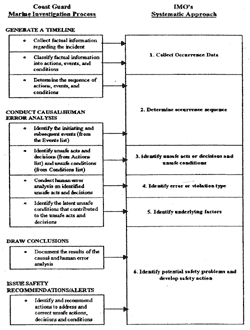|
MARINE ACCIDENT INVESTIGATION
PROCEDURES
OVERVlEW
BY
CHARLES BARBEE & DAVID DEAVER
THE MARINE INVESTIGATION PROCESS AND POLICY
I. INTRODUCTION
In complex systems, such as the maritime transportation system, there are many interactions between the operational parts of the system including: the mariner, shoreside workers, management, the equipment and materiel of a vessel and shoreline facilities, vessel traffic services, Aids to Navigation, publications, charts, manuals, and the environment. Because of the complexity of the maritime transportation system, there is the constant danger that critical information will be overlooked or lost during a marine investigation. To avoid this, the U.S. Coast Guard's Marine Investigation Process, which is based on and mirrors the approach prescribed by the International Maritime 0rganization (IMO), was developed. The steps of that process are listed in figure I-1 below along with a visual representation of their relationship to the corresponding steps in the IMO's systematic approach.
Figure I-1
| (拡大画面:66KB) |
 |
II. GENERATING A TIMELINE
The timeline is used to document the "who, what, when and where" of the incident. The marine investigator should use the SHEL model as an organizational tool for the collection of the factual information regarding the human aspects of the incident that make up the timeline. Once all the pertinent information has been collected and sequentially organized to give the "when" part of the timeline, it is classified into actions, events and conditions. These steps provide the "who, what and where" part of the timeline. See Enclosure 1. III. CAUSAL ANALYSIS
After collecting all pertinent information and the development of the incident timeline, the marine investigator conducts Causal Analysis to determine "how and why" it happened. The process of conducting Causal Analysis can be thought as occurring in several stages:
・Identify the Initiating Event and the combination of Unsafe Act(s)/Decision(s) and Condition(s) that caused it.
・Identify the Causal Factors of the Unsafe Act(s)/Decision(s) and the Condition(s).
・Identify the Defense Failures that allowed subsequent Events to occur.
See Enclosure 2.
IV. HUMAN ERROR ANALYSIS
For every unsafe act or decision identified in the first stage of the causal analysis, the marine investigator should determine the type of human error involved using the GEMS process:
・Determine whether the unsafe act or decision was a Planning Error or Execution Error.
・Determine the classification of Planning or Execution Error.
V. CONCLUSIONS
Conclusions are the results of the Causal and Human Error analysis as they relate to the incident. Conclusions should generally be stated in a "cause = effect" statement and are classified as either direct or inferred. A direct conclusion is made when the analysis of factual information and associated evidence leads to only one possible result. An inferred conclusion is made when the analysis of factual information and associated evidence leads to one or more possible results and the investigator must rely on his/her professional experience and knowledge to decide which of the possible results is most likely true.
VI. SAFETY RECOMMENDATIONS
The purpose of Safety Recommendations is to propose corrective actions for identified unsafe conditions or other unwanted outcomes deemed necessary to prevent those conditions from contributing to future casualties. They should be based upon and flow logically from the timeline, causal and human error analysis and conclusions of the investigation. To determine whether a safety recommendation is appropriate, the marine investigator should ask the following questions:
・Has the existence of a specific condition been identified?
・Has that condition been determined to be unsafe?
・Can control be exercised over that condition?
・Has it been determined that controls do not currently exist that adequately address that condition?
Safety recommendations must address actual unsafe conditions rather than hypothetical conditions. Safety recommendations may be made to address any unsafe condition identified during an incident investigation, including those that did not cause nor contribute to the specific incident under investigation. When doing so, marine investigator will need to include an explanation of the risks and probable consequences associated with the continued existence of the condition, as it will not necessarily be evident. Safety recommendations should only be made to address those unsafe conditions over which some level of control can be exercised through the implementation and use of control measures. Control measures include conventions, laws, regulations, policies and procedures. They should only be made to address unsafe conditions when one of the following is true:
・There are no current control measures in place.
・The current control measures are found to be inadequate.
Safety recommendations should not be made when the unsafe condition was the result of non-compliance with an existing control measure (e.g. a mariner ignored the prohibition against smoking during a transfer operation), a.k.a.a violation.
|